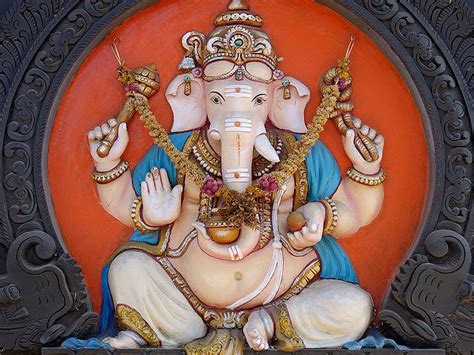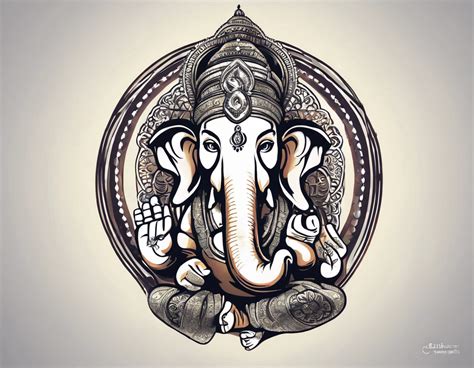Beyond the realm of ordinary perception lies a mystical entity whose symbolism and significance have captivated hearts and minds for centuries. In the pantheon of Hindu deities, one figure stands tall, both figuratively and literally, with the head of an elephant and the body of a man. Rumored to hold the key to profound wisdom and divine protection, this enigmatic being is none other than Lord Ganesha, the epitome of spiritual power.
Within the ancient texts and scriptures of Hindu mythology, Lord Ganesha emerges as a symbol of auspiciousness, intellect, and remover of obstacles. The mysterious iconography that surrounds this deity portrays a union of human and animal attributes, signifying the harmonious coexistence of the mortal and divine realms.
Embracing an aura of celestial might, Lord Ganesha wears the crown of rulership, representing his supreme authority over the universe. His elephantine features, emanating both strength and grace, embody the concept of overcoming adversity through intelligence and adaptability.
As we venture deeper into the depths of Lord Ganesha's symbolism, this profound exploration will shed light on the multifaceted aspects of his divine essence. Through tales of his origin, lessons from his symbolism, and the practices of his devoted followers, we will endeavor to unravel the secrets hidden within the touchstone of Hindu spirituality. Join us on this transformative journey and unlock the gateways to understanding the mystique that envelops the elephant-headed deity like an ethereal mist.
Diving into the Rich Mythology of Ganesh: A Treasure Trove of Tales and Symbolism

Exploring the diverse and captivating universe of Ganesh mythology unveils a boundless collection of stories and symbolism that have captivated generations. This treasure trove of tales offers a profound understanding of the multifaceted nature of Ganesh, the deity revered as the remover of obstacles and the patron of intellect and wisdom.
- Birth and Divine Origins: Delve into the enchanting legends that surround the birth of Ganesh, tracing his divine origins and the circumstances that led to his distinctive elephant head. Discover how these stories symbolize the importance of adaptability and acceptance, and the inherent wisdom that comes with embracing one's unique characteristics.
- Adventures and Heroic Feats: Uncover the extraordinary adventures of Ganesh and his heroic feats that embody his divine qualities. From vanquishing demons to restoring balance and order, these tales showcase Ganesh's unwavering courage and determination in overcoming obstacles that hinder spiritual and personal growth.
- Symbolism and Iconography: Decode the symbolism embedded in the various forms and representations of Ganesh. Explore the significance of his elephant head, multiple arms, and distinctive attributes, such as the broken tusk and the lotus. Gain insights into their deeper meanings, which reflect aspects of Ganesh's character and his role as a deity embodying wisdom, prosperity, and auspiciousness.
- Worship and Rituals: Gain a deeper understanding of the rituals associated with Ganesh worship and their significance in Hindu traditions. From the annual celebration of Ganesh Chaturthi to the daily prayers and offerings made to Ganesh, these rituals foster devotion and gratitude while reinforcing the belief in Ganesh's ability to grant blessings and remove obstacles from devotees' lives.
- Influence on Art and Culture: Explore the enduring influence of Ganesh in art, literature, music, and popular culture. From ancient sculptures to contemporary paintings, Ganesh's presence transcends time and geographical boundaries, influencing various art forms and inspiring creativity. Dive into the vibrant world of Ganesh-inspired art and discover how its widespread appeal continues to resonate with people of diverse backgrounds and beliefs.
Intricately woven with ancient wisdom and timeless symbolism, the mythology of Ganesh offers a profound exploration into the complexities of human existence, spirituality, and the pursuit of wisdom. Whether delving into the tales of his birth, contemplating his heroic adventures, deciphering his symbolic representations, participating in rituals, or marveling at his artistic legacy, the study of Ganesh's mythology proves to be an enriching and enlightening journey that unveils the mystical depths of this revered Hindu deity.
Unveiling the Tales Behind Ganesh's Creation and Birth
Exploring the intriguing lore surrounding Ganesh's origin and entrance into the world unveils a captivating narrative that presents different accounts and interpretations. This section delves into the diverse stories and mythical explanations revolving around the creation and birth of the elephant-headed deity.
In various ancient Hindu scriptures, such as the Puranas and the Mahabharata, several tales offer distinct insights into Ganesh's birth. One prominent narrative revolves around the goddess Parvati, who meticulously crafted an exquisite figure out of her divine essence, later infusing it with life. This divine sculpture, infused with maternal love and devotion, eventually transformed into the beloved deity known as Ganesh.
- Another cosmic legend suggests that Ganesh was created by Lord Shiva, Parvati's consort, during a moment of divine inspiration. Overwhelmed by his love for Parvati, Shiva fashioned a powerful, elephant-headed being as a symbol of his affection and devotion.
- Additionally, scriptures narrate an intriguing account of Ganesh's birth involving a celestial incident. According to this myth, when the moon ridiculed Ganesh's peculiar appearance, it faced divine retribution. As a consequence, the moon was cursed with eternal darkness, signifying Ganesh's authority over pride and arrogance.
- Furthermore, some interpretations propose a fascinating tale where Parvati inadvertently transforms her own reflection into Ganesh after admiring herself in a mirror. This allegorical narrative highlights the significance of self-awareness and self-acceptance in Ganesh's portrayal.
These diverse tales shed light on the rich mythology surrounding Ganesh's creation and birth, offering profound insights into his symbolism and divine attributes. Each narrative carries its own unique message, emphasizing themes of love, devotion, and overcoming obstacles. Unraveling these ancient stories enhances our understanding and appreciation of the beloved elephant-headed deity.
Exploring Ganesh's Unique Appearance: The Symbolism of the Elephant Head

In this section, we delve into the distinctive physical features of Ganesh, the revered Hindu deity who is often depicted with an elephant head. By understanding the symbolism behind this unique aspect of Ganesh's appearance, we can gain deeper insights into the spiritual and cultural significance associated with him.
The Elephant Head: A prominent feature of Ganesh, his elephant head symbolizes wisdom, intelligence, and strength. The elephant is revered for its immense size and power, and by giving Ganesh an elephant head, it emphasizes his ability to remove obstacles and bestow wisdom upon his devotees.
Wisdom and Intelligence: The elephant is considered a symbol of knowledge and wisdom in Hindu mythology. By having an elephant head, Ganesh embodies these qualities, suggesting that he possesses infinite knowledge and the ability to grant his followers with divine wisdom.
Removal of Obstacles: The elephant trunk, a versatile tool capable of uprooting trees and gathering delicate flowers, represents Ganesh's ability to remove obstacles from the path of his devotees. It is believed that invoking Ganesh's blessings can help overcome challenges and ensure success in endeavors.
Grace and Gentleness: Despite his immense strength, Ganesh is commonly depicted with a calm and gentle disposition. The elephant head further emphasizes his compassionate nature, reminding us that power can be accompanied by kindness and grace.
Union of Human and Animal: The combination of a human body and an elephant head embodies the union of the mortal and the divine. It signifies the integration of various aspects of existence, symbolizing the unity between the physical and spiritual realms.
In conclusion, Ganesh's elephant head carries profound symbolism, representing wisdom, intelligence, obstacle removal, compassion, and the merging of human and divine. Understanding these significance adds depth to our understanding of Ganesh as a Hindu deity.
The Profound Significance of Ganesh's Four Arms: A Deity of Equilibrium and Might
In Hindu mythology, Ganesh, the elephant-headed god, is revered for his divine attributes that symbolize balance and strength. His depiction with four arms holds a deep spiritual significance, representing the harmonious union of various aspects of existence. Each arm carries symbolic representations that embody Ganesh's supreme powers and his ability to navigate the complexities of life.
First and foremost, Ganesh's four arms signify his omnipotence and immense capability. With each arm manifesting a specific attribute, Ganesh encompasses a multitude of divine qualities. The four arms represent the elements of fire, air, water, and earth, symbolizing his command over the natural forces. This depiction highlights Ganesh's remarkable ability to govern and harness the elemental energies that shape the world.
Furthermore, each arm of Ganesh demonstrates his role as the eliminator of obstacles and the bestower of success. The upper right arm holds a goad, which acts as a guiding tool, indicating Ganesh's ability to lead devotees on the right path and steer them away from distractions. The upper left arm clasps a noose, symbolizing his power to seize and conquer hurdles that obstruct spiritual progress. Ganesh's lower right hand is raised in a gesture of fearlessness, inspiring his followers to overcome fear and uncertainties in their lives. Finally, the lower left arm holds a bowl of sweets, indicating Ganesh's benevolence and his role in offering rewards and blessings to those who wholeheartedly seek his divine intervention.
Lastly, the four arms of Ganesh represent the harmony of the physical and spiritual worlds. By embodying these four arms, Ganesh signifies the integration of the body, mind, and soul. The arms serve as a reminder of the holistic approach one must adopt to achieve equilibrium and unlock one's true potential in life. Ganesh's four arms embody the unity of opposites, emphasizing the need for balance and harmony in every aspect of existence.
The profound significance behind Ganesh's four arms unveils a deity that epitomizes equilibrium and power. This multifaceted representation not only reinforces his ability to overcome obstacles but also encourages individuals to find balance within themselves and their surroundings. By invoking the essence of Ganesh's four arms, devotees seek to embrace the divine qualities of balance, strength, and harmony that this beloved Hindu deity embodies.
FAQ
Who is Ganesh and what is his significance in Hindu mythology?
Ganesh is a Hindu deity who is known as the remover of obstacles and the god of beginnings. He is depicted as an elephant-headed figure and is believed to bring good luck and prosperity. In Hindu mythology, Ganesh is the son of Lord Shiva and Goddess Parvati and is highly revered by Hindus.
What is the symbolism behind Ganesh's elephant head?
The elephant head of Ganesh symbolizes wisdom, intelligence, and the ability to overcome obstacles. It is believed that Ganesh's elephant head represents his vast knowledge and wisdom, allowing him to guide his devotees through challenges and help them achieve success in their endeavors.
How is Ganesh worshipped and celebrated in Hindu culture?
Ganesh is worshipped and celebrated in Hindu culture through various rituals and festivals. One of the most popular festivals dedicated to Ganesh is called Ganesh Chaturthi, where devotees install idols of Ganesh in their homes or public places and offer prayers and offerings. During this festival, people sing devotional songs, perform dances, and immerse the idols in water at the end of the celebrations.



